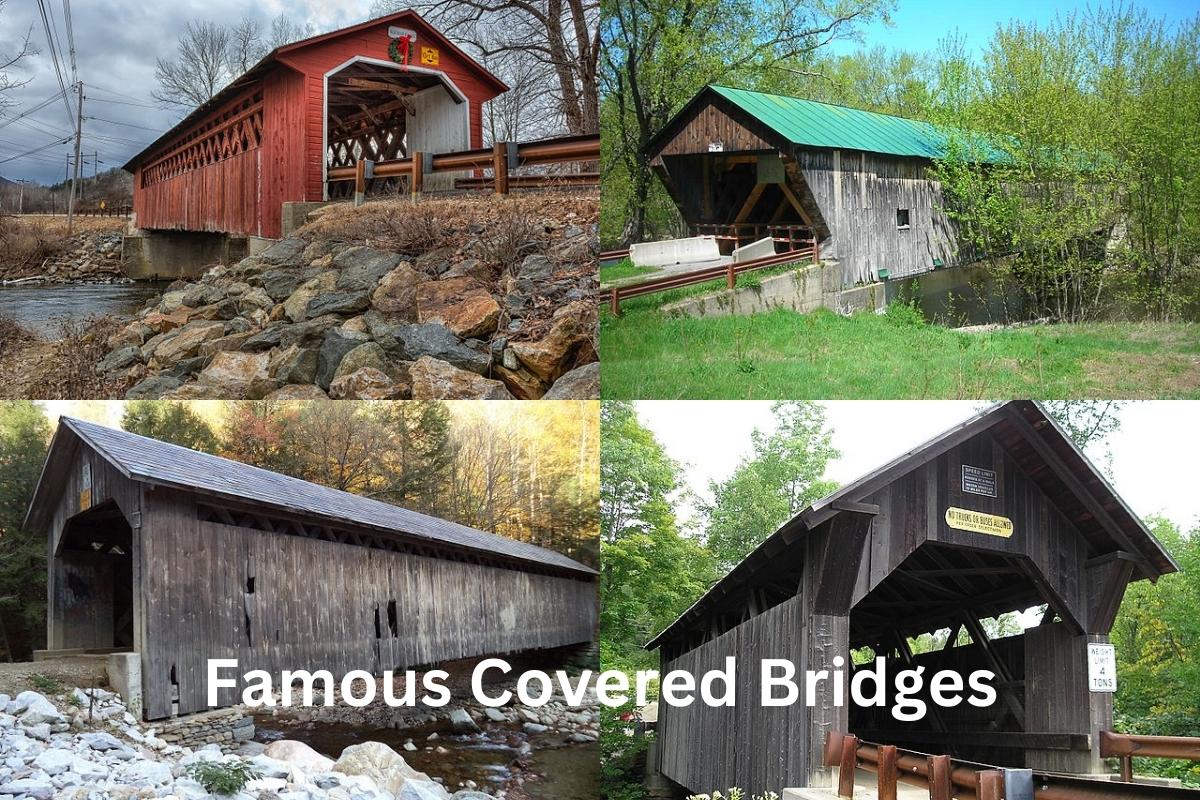Covered bridges are a type of timber-truss bridge that is enclosed on three sides by a roof, decking, and siding.
Due to the impacts of rain and sun, an uncovered wooden bridge normally only lasts 20 years, whereas a covered bridge might last for more than a century.
Only roughly one in ten covered bridges in America made it through the last century.
These bridges aim to prevent a build-up of snow. The majority of covered bridges are made of timber trusses and feature roofs, decking, and siding that together form a near-complete enclosure.
The covering is used to shield the wooden support beams from the elements. Here are ten of the most famous covered bridges across the world.
Famous Covered Bridges
1. West Dummerston Covered Bridge
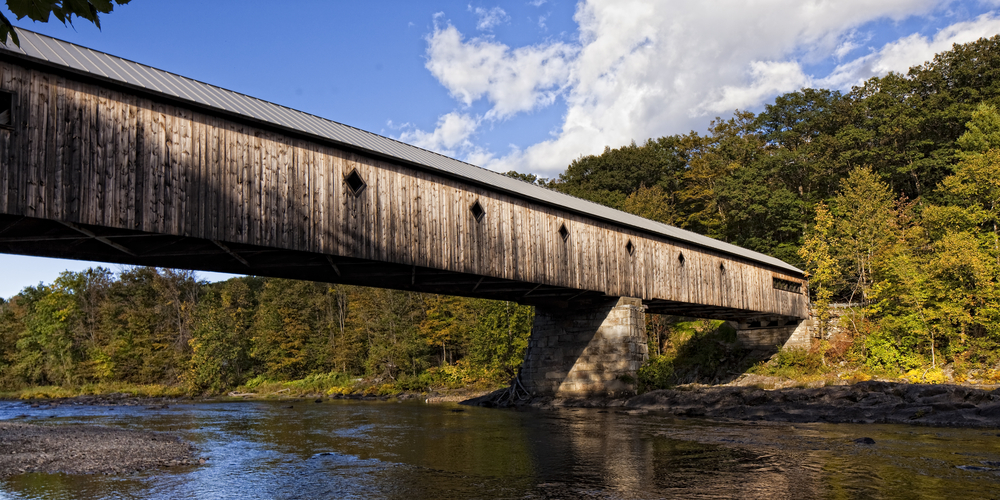
In Dummerston, Vermont, between Camp Arden Rd and Vermont Route, you’ll find this historic covered bridge.
Constructed in 1872, it is the longest covered bridge in Vermont, measuring a full 280 feet in length. In 1973, it was added to the list of National Historic Landmarks.
Two Town lattice trusses hold up each length of the bridge, plus flush vertical planks line the sides. In the meantime, wooden clapboards cover the ends. Over the original timber shingles, the roof is covered with corrugated metal.
Diamond-shaped windows in the walls let in more natural light. For all we know, this bridge, constructed by renowned creator Caleb Lamson in 1872, is the sole structure of his still standing in the county.
2. Campbell’s Covered Bridge
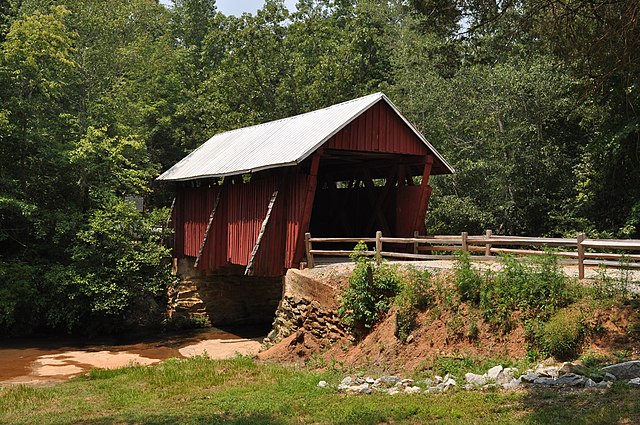
The wooden Campbell’s Covered Bridge spans Beaverdam Creek on Pleasant Hill Road in South Carolina’s northeastern Greenville County, not far from the quaint little village of Gowensville.
The historic Campbell’s Covered Bridge in South Carolina is the state’s final surviving covered bridge. Greenville County, which owns the land, banned automobiles from using it in the 1980s.
For its historical significance, in July 2009, the bridge was included in the National Register of Historic Places.
Charles Irwin Willis (1878-1966) constructed the bridge in 1909, and it was named after Alexander Lafayette Campbell (1836-1920), who owned and operated an adjacent grain mill for many years, of which some structures are still standing.
3. Hartland Covered Bridge
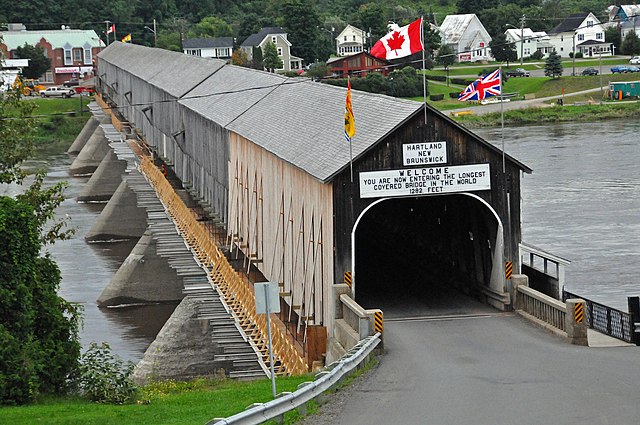
This bridge, situated in Hartland, New Brunswick, is the longest of its kind worldwide, measuring 391 meters.
Its fame has increased despite having survived a fire and a collapse of the surrounding ice. From Hartland to Somerville in Maine, you can cross into New Brunswick via the St. John River Bridge.
In 1898, the Hartland Bridge Company began working on plans and specifications for the bridge, and by 1901, it was ready for use. In May 1901, Dr. Estey used the bridge for the first time before it formally opened to the public because of an emergency.
The laborers had to lay planks so they could cross the bridge. It was consecrated by Justice McKeown on July 4, 1901, in front of a crowd of around 2,000 people.
After being funded by tolls, the provincial government finally acquired it on May 1, 1906. Now, the bridge serves as a pedestrian walkway and historical landmark.
4. Wawona Covered Bridge
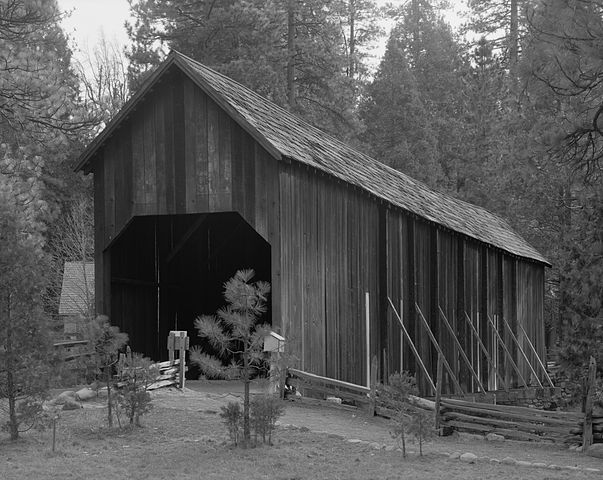
Covered bridge across the Merced River’s South Fork of in Wawona. When first constructed by Galen Clark, this bridge was only a simple, exposed structure.
Clark played a key role in securing the Yosemite Grant of 1864, which permanently protected the Giant Sequoias’ Mariposa Grove as well as Yosemite Valley.
The bridge was constructed by Clark in 1857, not long after he had settled in Wawona. The three Vermont brothers who owned the brand constructed Wawona Hotel spearheaded the push to have the bridge covered in 1879.
The Washburn brothers, by all accounts, were affable, prosperous, and exceptionally astute in the ways of business.
Still, they were far from home and perhaps felt some homesickness. One of their grandchildren claims that the brothers covered the bridge in walls as well as a sloping roof to honor their New England roots.
5. Silk Covered Bridge
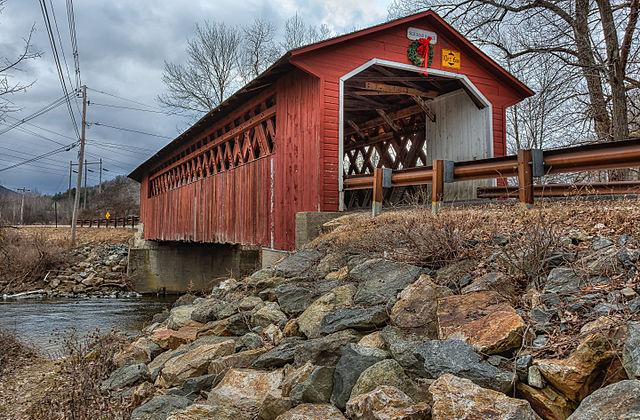
Silk Road crosses the Walloomsac River on the covered bridge known as the Silk Covered Bridge, connecting the town of North Bennington to the city of Bennington in Vermont.
This 1840 Town lattice truss bridge is one of three similar structures spanning the river on either side. In 1973, it was given official recognition as a National Historic Landmark.
The location of the bridge is primarily rural. It spans the Walloomsac River, which flows to the west, north to south.
Both its northern and southern abutments are made of concrete, while the northern one is an original stone slab that was repurposed for the job. The Town lattice truss bridge is 88 feet in length and 15 feet in width.
There are vertical boards on the bridge’s sides and inside the portals, and flush horizontal planks on the portals’ outer ends. Boards don’t reach the full height of the truss at the bridge’s central section.
6. Pulp Mill Covered Bridge
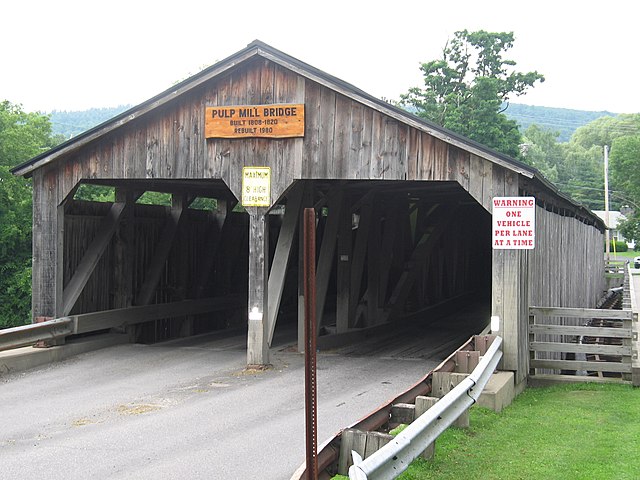
Located on Seymour Street between Weybridge and Middlebury, this wooden covered bridge spans Otter Creek. As of 1974, it is recognized as a National Historic Landmark. A Burr arch was used in the construction of the bridge.
Around 1860, the bridge’s type was changed from a Burr arch to a King post with a Burr arch design, which involved the removal of the old Burr arches and their replacement with laminated ones.
There are a lot of unique features of this bridge. There are just seven other covered bridges in the entire United States, and this one is one of only two that still sees daily traffic. In addition to being one of the oldest covered bridges in the United States, it is also the oldest in Vermont.
It’s unclear how old the bridge is. The bridge’s marker claims it was constructed sometime from 1808 to 1820. Using his thorough understanding of covered bridge design and a review of the Minutes of the Selectboard of the Town of Middlebury, encased bridge specialist Jan Lewandowsky estimated that the bridge was built around 1850.
In the Town of Middlebury, Vermont, 1850 dispatched an observer to the nearby Town of Essex to take a look at the freshly built Burr Arch bridge.
7. Brown Covered Bridge
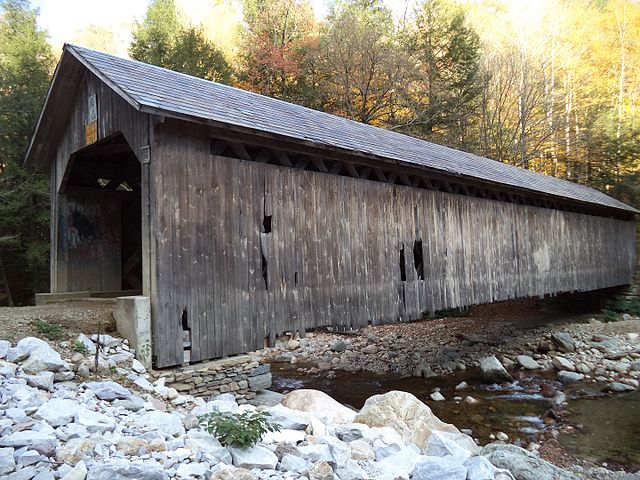
Located roughly 5 miles southeast of Rutland, Vermont, the Brown Covered Bridge is hidden away in a wooded ravine in northeastern Shrewsbury.
It is a single-span lattice truss bridge, a design first used by architect Ithiel Town in his 1820 patent. It stretches for a hundred feet and is supported by concrete-capped stone abutments.
The bridge has been adapted to its environment, with a massive boulder serving as one of the abutments. The slate roof was formerly a popular local variant on covered bridges, but this structure is thought to be the only one left in the United States. It is covered in vertical weatherboards and has an eave window.
The roadway width of the bridge is 13.6 feet. One of the best and least modified variants of a Town lattice truss-covered overpass in the U. S., this bridge was constructed in 1880 by renowned Vermont bridge right Nichols M. Powers and was named a National Historic Landmark in 2014.
8. Hammond Covered Bridge
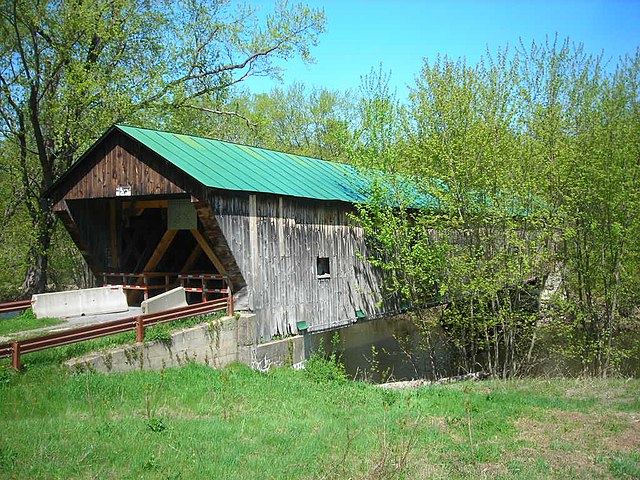
In Pittsford, Vermont, there is a town lattice-covered bridge that goes over Otter Creek. In 1842, Asa Norse constructed this bridge to carry Kendall Hill Road, which presently goes south of it. In January of 1974, the bridge was included in the National Register of Historic Places.
The creek runs east to west, and the bridge crosses it in that direction. The trusses on this single-span Town lattice bridge are 139 feet in length, and the roadway is 18 feet wide.
The concrete pad sits atop the abutment’s original stone and marble slab construction on the eastern abutment, while the western abutment is marble-topped concrete.
Laminate beams installed below the bridge’s trusses strengthen it. Vertical board siding wraps the building from the exterior to the gateway faces and even reaches inside for a little while. The square windows in the roof of this corrugated metal building let in natural light.
9. West Montrose Covered Bridge
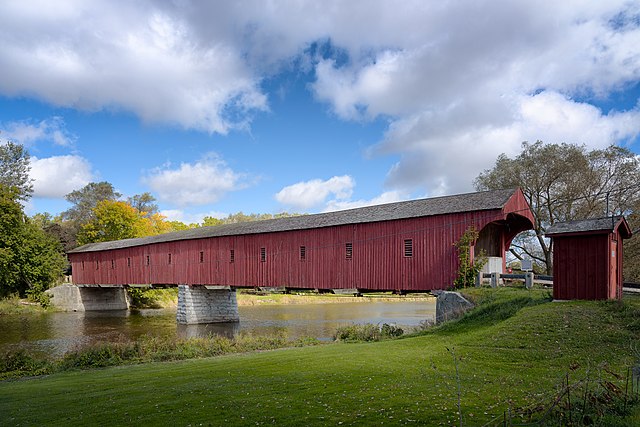
The West Montrose Covered Bridge, also known as the Kissing Bridge, can be found in West Montrose, Ontario, and is among the oldest encased bridges in the country. In 2015, fewer than 200 of Canada’s historic bridges remained open to traffic.
John Bear, who had previous experience constructing barns, built the bridge in 1880–1881. He used a combination of oak and white pine. At the time of its construction, it was estimated that the structure would have a useful lifespan of 70 to 80 years.
Recent maintenance has made that much better. A lot of steel and concrete reinforcements were added to the aging framework as part of the restoration project’s main improvements. The bridge’s current look, however, is identical to that depicted in the plans.
10. Gold Brook Covered Bridge
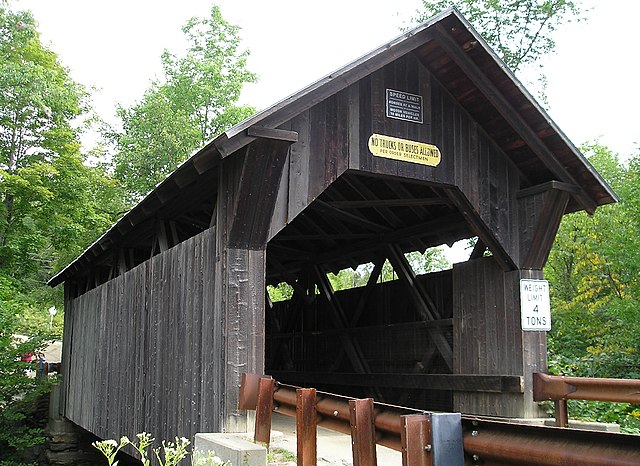
This bridge spans Gold Brook in the Stowe Hollow neighborhood of southeast Stowe. The highway on this Howe truss bridge is 13.5 feet wide, while the bridge itself is 48.5 ft long as well as 17 ft broad. It is supported by abutments made of dry-laid stone and has a metal roof with a gable design.
Vertical board siding covers the majority of the exterior, stopping just short of the eaves. The cladding goes all the way to the interior of the windows and doors. Wooden planking serves as the bridge’s decking.
John W. Smith constructed this timber Howe truss bridge in around 1844; it is the only one of its kind in the state.
The Howe truss was patented in 1840, making it an early example of its type. Plus, it’s the last covered bridge from the 19th century in Stowe. There’s a reason it’s on the National Register of Historic Places: 1974.

